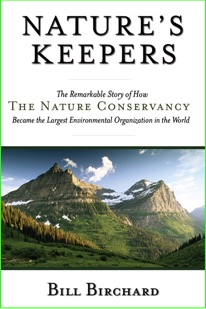

THE STORY OF THE NATURE CONSERVANCY
NATURE’S KEEPERS
Chapter 1: No Crisis Unanswered
The people of the Nature Conservancy had plenty of warning that the Washington Post was going to sully their image. More than a year before a series of articles began on Sunday, May 4, 2003, reporters showed a taste for the Conservancy’s knottiest transactions. Eight months before, they dug into the Conservancy’s darkest deal—rustling natural gas from a neighbor’s deposit in Texas. A few days before, they called to say the stories would run on the front page for three days in a row.
The Post reporters had done their homework on Conservancy foul-ups, and they were going to run an exposé that, in the eyes of Conservancy faithful, wasn’t pretty. That much everyone knew.
But when the Post series broke, Conservancy insiders recoiled in outrage. They felt abused and violated. The Conservancy, said the Post’s first story, was the “the world’s richest environmental group” and a “corporate juggernaut.” It logged forests and drilled for natural gas. It sold its name and logo for profit and bought land to resell to insiders. The Conservancy’s list of errors and indiscretions ran for eight inches down the newspaper column.
Many people wondered why the Post didn’t look more at the Conservancy’s success. After all, measured by revenues, it is the largest environmental group in the world, bringing in over $800 million each year. It employs 3,450 people operating from four hundred offices in fifty states and twenty-eight countries. No other organization surpasses the Conservancy’s record of on-the-ground results. It protects more than a million acres of land a year, for a total of 120 million acres to date. As for foul-ups, well, they happen at any big organization.
The story of that success actually starts fifty years ago. It is a story about men and women building a top-tier institution, one of the preeminent in the nonprofit world. This is a conventional success story. But this book is also a story about men and women overcoming crises and challenges—only the latest of which emerged as a result of coverage in the Post. This is the more complex story of people repeatedly taking steps to transform and improve the way they work—and continue to log achievements that count, and count big.
The story of any organization’s success pivots on crises and challenges—crises and challenges experienced by the individual, the team, and the institution. The ability of people to weather and profit from these events, sometimes the most daunting or nerve-racking of their careers, separates organizations that thrive from those that do not. Still, they are crucibles of learning that force people to rethink behavior, rewrite rules, reconfigure processes, and reinvent the way they work.
Among the crises and challenges that yield lessons about success at the Conservancy:
• Weak or inappropriate leadership, a crisis striking at the heart of almost every organization, challenged the Conservancy several times in its early years. The board had to face up to leaders poorly matched to the organization’s evolving needs.
• Mission drift and confusion, a crisis in focus that creeps up slowly but nonetheless cripples organizational effectiveness, revisited the Conservancy more than once. At times, opportunism and indiscipline prevailed.
• Confused and weak organizational culture, a challenge that blocks an organization from achieving high-performance, faced the Conservancy in its adolescence. Conservancy leadership had not yet inculcated a mature organizational personality.
• A dead-end business model, a crisis that emerges as an organization tackles bigger societal needs, faced the Conservancy as it sought to break from a tradition of almost exclusively small-scale nature-preserve conservation. People stumbled as they learned the new capabilities required to operate at a broader scale and bigger scope.
• A disempowered board, the sleeper crisis in performance at so many nonprofit groups, perennially hampered the Conservancy, particularly on its state-chapter boards. Conservancy leaders struggled to go beyond asking their boards to give money and arrange connections with the rich and powerful.
• Ad hoc management, the make-management-up-as-you-go habit of small organizations, hobbled the Conservancy as it expanded to fifty state offices. The pluses of decentralized management became minuses for the performance of the whole.
• Homegrown international expansion, or using an ad hoc approach to expanding globally, created a promising but diffuse strategy for overseas conservation. Conservancy leaders eventually had to rethink their approach to meeting the needs of conservation internationally.
• A crisis in public accountability, triggered by the scrutiny of investigative reporters, shook the halo from the Conservancy. Lapses in oversight combined with more demanding public expectations damaged the Conservancy’s reputation, especially in the court of public opinion....
Copyright © 2005 by Bill Birchard
Buy Book From
Quick Links